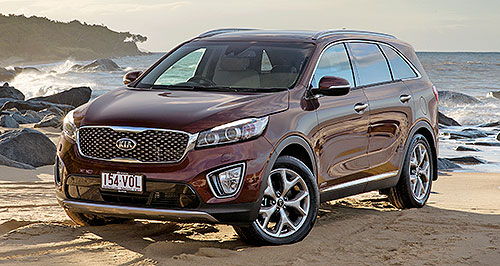Sorento a challenge for local Kia engineers
BY DANIEL GARDNER | 8th Jun 2015

While most vehicle types have a more consistent purpose, large SUVs have a greater variation of ownership and uses, according to the South Korean car-maker.
When the local chassis team set to work honing the third-generation Sorento's chassis, its multi-faceted application caused significant challenges for the engineers, who had to provide a comfortable ride for passengers, a rewarding drive and respectable towing ability.
Speaking at the launch of the new Sorento in Queensland last week, Kia Motors Australia (KMAu) technical consultant Graeme Gambold told media the broad range of uses for a large SUV make it tricky to “appease as wide a demographic as it can with a nice urban ride, satisfactory dynamic performance”.
“Whereas something like a Cerato (small car) or Carnival (people-mover) even, it's got a narrower window of what it's got to do,” he said.
“A car like this is covering a wide user demographic. Some people just want it as a mum's taxi and others actually want to do hard towing with it.
“In this country it's one of the hardest markets for that sort of car. Something like a Sorento does have to have a towing capacity and that defines what spring rates you can have in the back of it.” With many Australian motorists wanting to tow trailers and caravans, the local tuning team had to formulate a specific suspension set-up that serves owners wanting to use the Sorento as a people-mover, as well as those wanting to tow.
Mr Gambold explained that for a reasonable towing capacity, higher-rate rear springs are required but the stiffer versions adversely affect ride quality, so a careful balance had to be found.
“We always want to be up on the high end of spring rate for a car like this, which compromises our ride,” he said. “In the previous XM, the spring rates were too low.
“KMC (Kia Motors Corporation) jacked the rear spring rates up by design and then we are at the ceiling with the heaviest rear springs we can have globally and we wanted more but we are outside the window.” Despite the significant challenge, Mr Gambold's team managed to fit heavier springs for towing, but honed the ride with careful attention to the chassis and a unique combination of spring, anti-roll bar and dampener settings.
“The roll-angle is actually very low in this car,” he said. “In the long corner its actually only got 3.5 degrees of front roll per 1G which is quite low for an SUV and certainly the lowest we've seen. It's in the Volkswagen Touraeg area.” When all of the chassis tuning was complete the engineers turned their attention to the Sorento's steering, which features all-new “rack-motor” power steering technology that will be progressively rolled out across the Kia range.
The Sorento is the first model to use the new type of steering rack that was developed by Korean steering specialist Mando and chassis/drivetrain authority ZF, and provides “more direct feel and that's because the actual rack is connected straight to the steering wheel,” according to Mr Gambold. “It's far more accurate.
“We do it at the end of suspension tuning so it integrates with the response that we have settled on. The steering is a big part of the dynamics. It's the technology that we're going to.” Kia's larger models will be the first to recieve the rack-motor technology, with the Optima mid-size sedan next in line for Australian launch in November. After that the system is expected to filter down across the range.
Kia Sorento pricing*
| Petrol | |
| Si (a) | $40,990 |
| SLi (a) | $45,990 |
| Diesel | |
| Si (a) | $44,490 |
| SLi (a) | $49,490 |
| Platinum (a) | $55,990 |